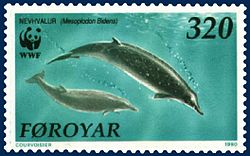| Mesoplodon | |
|---|---|
 | |
| Sowerby's beaked whale (on Faroese stamp) | |
| Scientific classification | |
| Kingdom: | Animalia |
| Phylum: | Chordata |
| Class: | Mammalia |
| Order: | Artiodactyla |
| Infraorder: | Cetacea |
| Family: | Ziphiidae |
| Subfamily: | Hyperoodontinae |
| Genus: | Mesoplodon Gervais, 1850 |
| Type species | |
| Delphinus sowerbensis [1] de Blainville, 1817 | |
| Species | |
16, See text. | |
Mesoplodont whales are 16 species of toothed whale in the genus Mesoplodon, making it the largest genus in the cetacean order. [2] Two species were described as recently as 1991 (pygmy beaked whale) and 2002 (Perrin's beaked whale), and marine biologists predict the discovery of more species in the future. [3] A new species was described in 2021. [4] They are the most poorly known group of large mammals. [2] The generic name "mesoplodon" comes from the Greek meso- (middle) - hopla (arms) - odon (teeth), and may be translated as 'armed with a tooth in the centre of the jaw'. [3]







